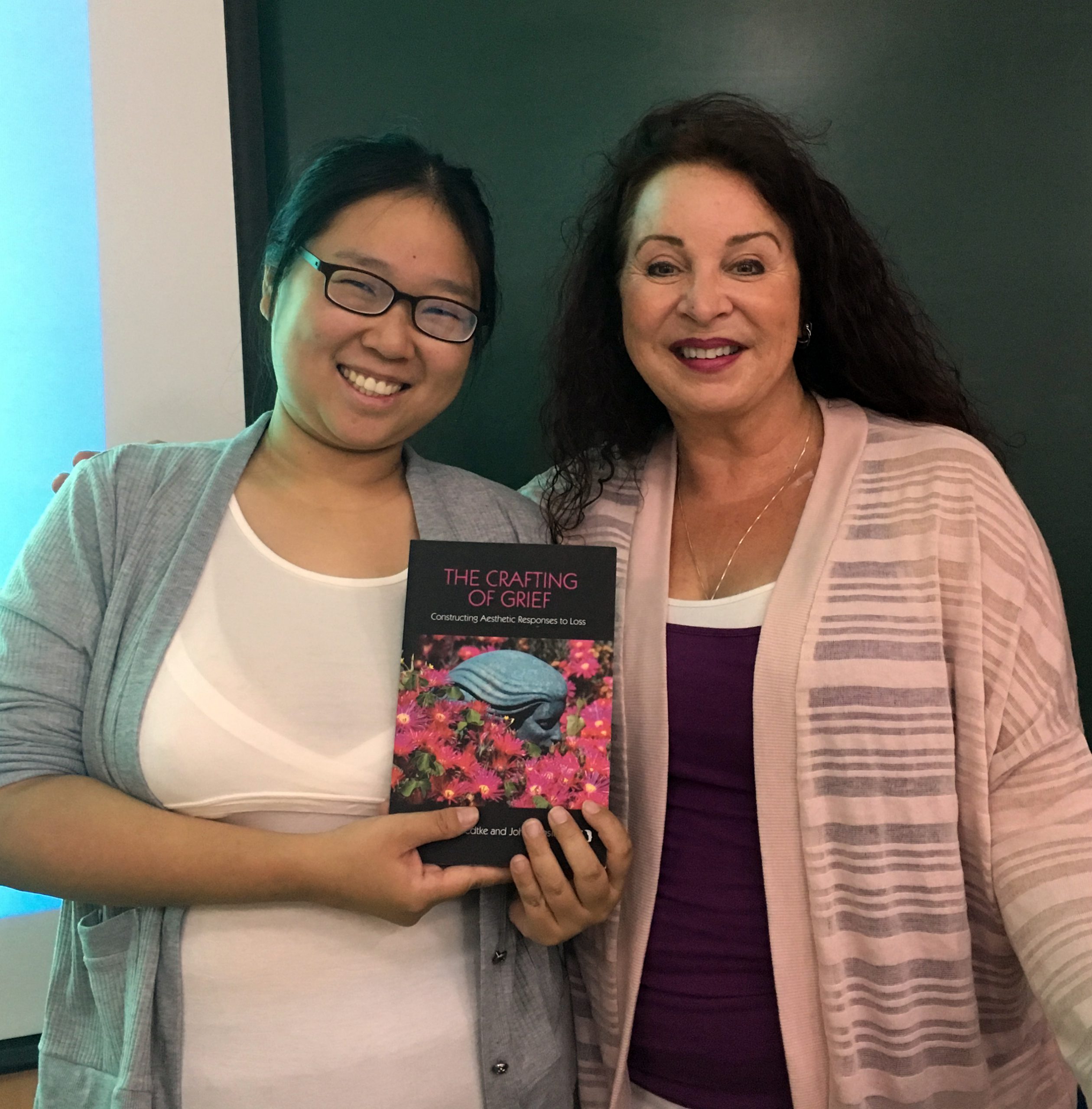
This is part one of a three-part series on building Remembering Convsersastions with clients and therapists*. Click here to join Lorraine’s mailing list and read the entire article in PDF format.
People often search for meaning to soothe the pain of grief. Some turn to religious doctrine or secular rituals, others towards counseling. Some may connect to ancestral stories to find genealogical meaning for their own lives. Death particularly challenges the meanings of a relationship. This post and the following posts showcase “remembering conversations” with a woman whose mother had recently died.
Rather than finding personal meaning solely in her own individuality, she is comforted by finding it in a renewed sense of lineage, connecting meaning to her mother, grandmother and her daughter. By crafting questions that focus on what remains following the death of a loved one, a counselor can assist the bereaved to connect multigenerational meaning with narrative legacies. These stories can infuse the relationship between the living and the dead, often affirming familial connections, with strength and vitality.
When a person who matters dies, the living are left with a desire to make sense of events. Circumstances dictate they make meaning of what has happened, accounting for the existential questions of life and death, but also for the changes in relationship. It is simply not good enough to create a premature goodbye or insist that people find closure, as these undermine the beauty that can be created. A bereaved person often seeks to fill a sense of yearning for the deceased.
Undercurrents in conventional grief psychology models have, at times, unwittingly led to the erasure of the deceased, including requirements for a final good-bye and the letting go of relationship. This omission not only obscures the life of the deceased person, but also inflicts unnecessary pain upon the immediate family and friends as well as all possible future connections. As the reader will find, the practice of remembering opposes acts that sever relational connections. In the particular story that follows, the matriarchal knowledge that can be willed to future generations are doubly threatened by the discounting of women’s knowledges in patriarchal practices. These domains of power and privilege follow people to the grave where some lives are considered grievable while others are not (Butler, 2004).
Bringing to life a storied connection with the deceased thus, becomes a political act that refuses relegation of a relationship to oblivion and in the process refuses the dominating influence of patriarchal discourse. Remembering is more than a quaint cultural practice or the private experience of continuing a bond. It becomes a platform for making a person’s life visible and encourages, for example, social justice projects that mattered to the deceased to be taken up by those who continue to live. In the process, the bereaved can find comfort and the deceased can be given a visible and just tribute for what they have stood for. Remembering affirms that a bond be continued, in this instance, through generations of women who have come before and those yet to be born to honor matrilineal knowledges.
When appropriately supported, the bereaved can find a renewed and rich ongoing connection with the deceased person that they continue to care about. This chapter explores how to facilitate such a rich, ongoing connection between the living and dead through the crafting of questions. Rather than thinking of death and grief as only an individual event, I will showcase the practice implications of addressing the despair of grief by thinking in relational terms and multi-generational legacies.
Many models of bereavement have been focused on the individual’s internal process of recovery, omitting the familial structure, support and changes. It could even be said that grief is always an event that is shaped by the family structures, rituals and meanings. The living continue to make sense of their grief in direct relation to the intricate patterns of interaction and relational knowledge of the constructs of the relationship that was, and the implications of the relationship to be.
This chapter will introduce “remembering practices”, a narrative approach to therapeutic conversation that transcends the barriers between living and the dead. These conversations build a narrative legacy into the bereaved person’s identity through transfusing the stories, strength, and love between generations. The thinking behind remembering conversations supports not only a narrative perspective but is closely aligned family systems approach as well, incorporating the relational threads between people’s stories that create substance. Remembering generates vitality and helps craft a way forward in which the bereaved need not exclusively carry the burden of grief, as is often the case in individual grief models. If we hold to a postmodern view of identity, meanings are formed in pliable social networks and not by isolated individuals. The responses to grief thus created can uphold the importance of multigenerational family ties.
To illustrate remembering practices, this chapter highlights a transcribed conversation between myself and Megan and her mother Paula.
My meeting with Megan was not the first conversation we had had about her mom. I had spoken with her mother, Paula, alone once before and once together with Megan. The conversation used here took place just three weeks after Paula’s death. Paula had been ill for fourteen months with an aggressive cancer and had undergone many challenging medical procedures. This conversation also coincided with the early part of Megan’s pregnancy, news of which she had shared with her mother before her passing. This grandchild was to be the first for Paula. These circumstances served as backdrop to a grief conversation that aimed to alleviate suffering and to uphold matriarchal knowledges that have, at times, been invisibilized in family therapy.
If this is your first introduction to Remembering Practices, we suggest clicking here to read our previous pieces on the history of grief psychology, ‘A better way to grieve our lost loved ones.”
Remembering Practices
Remembering conversations shift how we speak about the deceased. Narrative grief counseling does not require a solely individual perspective. Nor are the bereaved encouraged to excise the deceased person from memory or to reach a stage of acceptance of the loss.
Instead it focuses on the reincorporation of memories and on embracing the rich legacies found within families. Stories of hardships endured are often told and the teachings and values of the deceased are celebrated, long after the moment of death.
If a person’s stories do not die with the body, we are free to resurrect stories, retell and reincorporate them into the lives of the living.
Remembering expands understanding of time beyond a linear construction in which the deceased are relegated to the past, and instead generates clues to a relational future where a person’s legacy can be shaped through posthumous accountability and care of the deceased person(s) stories. While some might see these claims as fanciful delusions, those that participate in these conversations report feelings of comfort.
Remembering conversations select stories from the deceased’s life that might be useful to retain for the living. Finishing unfinished business becomes un- necessary, when we affirm the importance of ongoing relationship.
The relationship between the bereaved and the deceased morphs into something new, guided by the recollected words of the deceased.
However, in order to sift through which relational aspects may be useful, the deceased require an introduction. Counselors need to know who the deceased person was, what made them unique, what hobbies, work or joys they invested in, and what was precious about them. Introduction is more than social formality. It may also alert the counselor to relationships that might be troubled or abusive. If so, a counselor would need to exercise care about whether a relationship should be reinstated. This chapter will not explore how to craft conversations in the face of abuse or traumatic death, as this emphasis can be found elsewhere. The transcribed excerpts with Megan illustrate how a remembering conversation can benefit a positive relationship in which the desire to include the deceased in the lives of the living already exists.
Lorraine: Megan, can I get a sense of your mom? For those who don’t know Paula. How would you introduce her?
Megan: She’s the happiest, most carefree, easygoing person I’ve ever met. She can have fun doing anything – the grocery store, thrift store. L: So, easygoing, appreciated a good joke, was happy doing just about anything. Yes?
M: Uh huh. Because she was so easygoing and sweet and kind, I never realized she was a strong person. She just had this quiet strength. She never complained.
L: So what’s your best guess about how she was able to maintain that non-complaining stance during hard times, like with the cancer treatment? What did she call on to do that?
M: It’s incredible to me. I just know that was how she lived her life. Even when it was really tested, she maintained strength and a non- complaining way.
L: So what’s it like for you knowing that your mom was consistent? That before cancer, and during cancer, she was a woman who didn’t complain, was strong, had things to look forward to, enjoyed laughing?
M: It’s the best feeling in the world. I knew what to expect with her. It allowed me to be much more open, because she loved and accepted everything about me.
Introducing sets the stage for a different kind of approach to grief psychology.
It assumes from the beginning that the deceased continues to matter and the bereaved want to be accountable to the relationship. When psychology and medicine focus on the internal states of a grieving individual, this focus is left behind. Megan is asked to immediately call forward what is unique in their relationship. Through this the counselor not only gets a sense of Paula, but also of what is noteworthy in Megan’s life. Megan can invoke her mother’s strength or humor to respond to her own life challenges. They can become valued attributes that guide Megan, while keeping her connected to her mother’s abilities.
*Hedtke, L. (2016). Constructing matrilineal connections in a remembering conversation.
In, Dickerson, V., (Ed.), AFTA Springer briefs in family therapy. NY, NY: Springer
Publishing.
